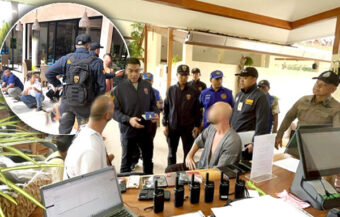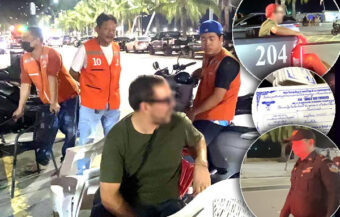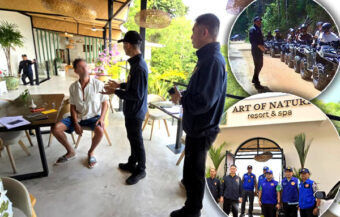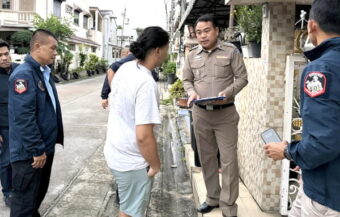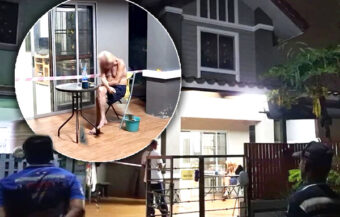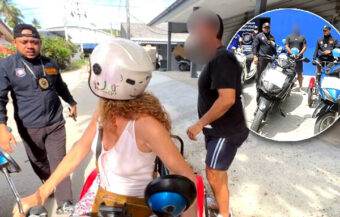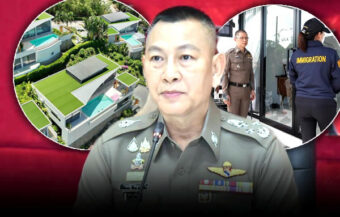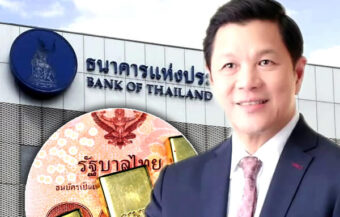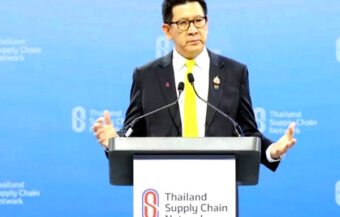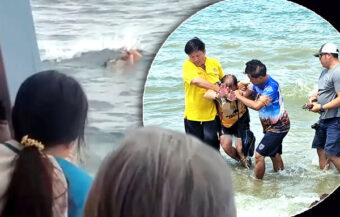Nearly 100 engineers and 16 cranes were involved in the three-day process which finishes up on Monday. On Friday, a leading Thai engineer warned that the BTS stations may be exposed to the danger of rust impacting the metal components within the concrete structures. Last Wednesday’s slab fall from the Ari station in Phayathai provoked concern among the growing number of users of the BTS Skytrain in Bangkok which has been a huge success and continues to expand since its launch in 1999.
Two days after a concrete slab came crashing onto a busy road last Wednesday morning in Bangkok, the director of Bangkok’s BTS Skytrain, Surapong Laoha-Unya, on Friday announced a thorough engineering survey of all 22 stations on both the Sukhumvit and Silom lines. The process is scheduled to finish up on Monday night.
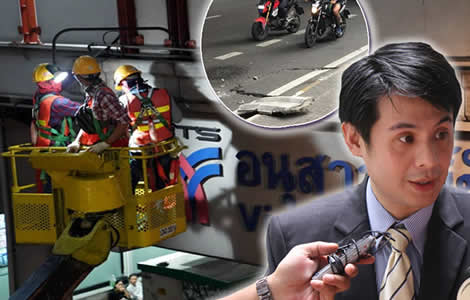
Emergency inspections began on Friday of Bangkok’s popular BTS Skytrain stations across the capital. It follows an alarming incident on Wednesday morning just before 7 am in a busy part of the capital when a concrete slab fell on to a busy road in the city narrowly avoiding causing injury or loss of life. The fact that the incident occurred early in the morning may have a lucky break for passersby and Thai authorities.
Inspections follows a shock last Wednesday when a slab fell from a BTS station on to the road narrowly missing vehicles and raising alarm
Even so, the incident on Wednesday morning saw the concrete slab narrowly missing vehicles and motorbikes on the busy road shocking pedestrians and drivers. It occurred at Ari station which serves the Phayathai area in Bangkok, a location with many office towers, shops, apartments and restaurants. From a height, the concrete slab fell onto the road with such force that the impact caused some parts of it to shatter. It was then removed to the kerb as it was impeding traffic.
Emergency medical practitioner described an early morning fright in the Phayathai area of Bangkok
A medical practitioner and emergency care specialist from Surin was nearby when the incident happened. She took photographs and posted them on her Facebook page. The Thai professional expressed concern at which she saw. ‘Good thing it didn’t hit anyone. A bus driver moved it onto the side of the road,’ Isara Ariyachaipanich described the scene just minutes afterwards. ‘If it had hit a car or a motorcycle, someone would have died for sure.’
Public concern as Facebook post is shared 5,300 times
The Thai woman’s Facebook post received over 5,300 shares and 3,300 comments from Thai people, many of whom expressed heir own personal apprehension and safety fears following what they saw in the photos. The BTS system has, by now, become a much-used resource for people living in Bangkok as well as foreign visitors. Many of those reacting would have been regular users.
Engineering probe looking for signs of wear and tear
The engineering inspections of the structures are expected to have looked for, among other things, the presence of rust deterioration both within and without the structures. This follows a warning after the incident this week from the president of the Thai Structural Engineers Association in relation to the susceptibility of components within the structures to rust. Professor Amorn Phimarnmas called for immediate and regular inspections of all facilities linked to the elevated Bangkok rail system.
Bangkok’s BTS rail system is a popular success
The impressive BTS system was launched at the end of 1999 and in more recent years has seen user levels take off. Comprising of two lines, the network has grown with 14 additional stations on the Sukhumvit line and 7 more on the Silom line since. Further extensions of the line are planned throughout that Bangkok and the extended metropolitan area.
Executive director of the Bangkok Skytrain announced the inspection move on Friday
On Friday, the executive director of the Bangkok Mass Transit Rail System, Surapong Laoha-Unya, announced the safety checks which began immediately. They were scheduled to be completed on Monday night when engineers will examine BTS stations in Sukhumvit including Siam, Chidlom, Ploenchit, Nana, and Asok stations. All 22 stations will have been examined over the three days. The operation is reported to have involved nearly 100 engineers working with 16 cranes.
Engineer warns of the danger rust to the BTS
The president of the Thai Structural Engineers Association explained on Friday that the basis for his fears was that both external and internal steel elements within the structures may be susceptible to rusting. One of the reasons for this, Professor Amorn suggested, was emissions of carbon dioxide from constant traffic on the roads where the structures are located at key intersections. He described a process where heightened carbonation in the environment may cause a change to the alkalinity of the concrete structure. This would be a cause of rust developing on metal parts.
Metal susceptible to a chemical reaction caused by carbon dioxide in the environment
He revealed that if the concrete slabs on the structure lacked depth then the metal underneath could be liable to develop rust. The chemical reaction caused by the highly carbonated atmosphere on the road intersections must be checked. Rainwater was also a threat to the structures, many of which are now approaching their twentieth year in operation. He was also concerned that some of the metal fasteners attaching the slabs to the structures may have been improperly installed.
Ongoing checking and monitoring required
Professor Amorn suggested that the safety checks should involve both observations by experienced engineering personnel and a test for rust using the half cell potential technique and electric current. This would confirm if rust was an issue for metal components inside the concrete structure.
The engineering leader called for such checking and monitoring to become an ongoing process after last week’s close miss.

